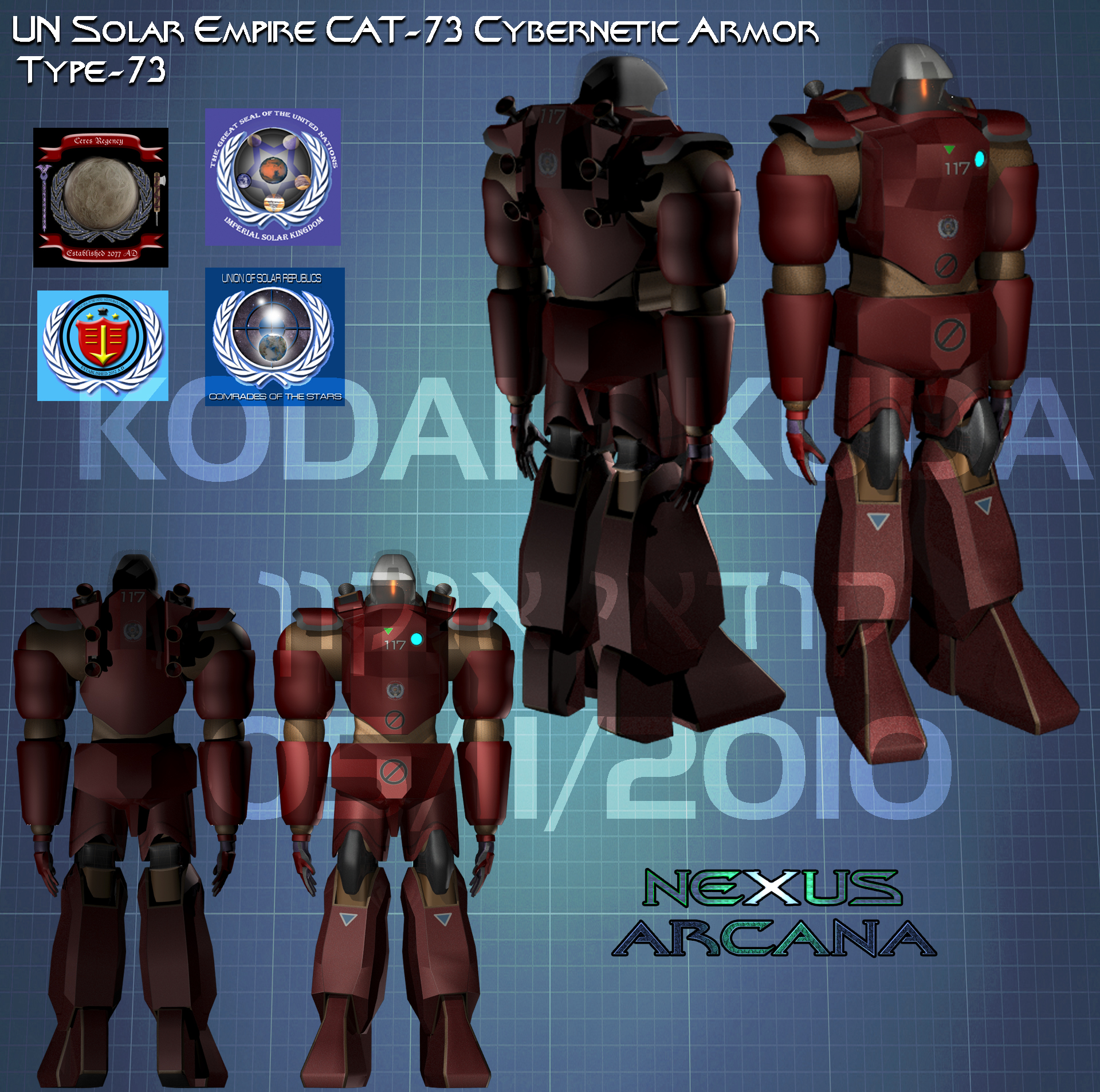 |
||
 |
||
The small arms and equipment of the Union of Solar Republics was identical to what the Solar Empire used due to the fact that Jupiter and the other former UNSC planetoids under their control housed large manufacturing plants dedicated to the production of the combat armor and infantry weapons of the Solar Empire. It was cheaper and easier for the USR to simply produce the same weaponry and armored suits that the Solar Empire had used rather than expend the time and resources to develop new ones.

GOVERNMENT:United Nations Socialist Solar Empire
TYPE: Exosuit
MODEL: CAT-73 Cossack class Cybernetic Armor
DATE INTRODUCED: 2173 AD
LENGTH: 3.5 feet
WIDTH: 4 feet
HEIGHT: 7.5 feet
MATERIAL: Crystal Composite
POWER PLANT: Hensai Energy HEFC-80kw fuel cell (1)
OUTPUT:80 kilowatts
LIFE: 20 hours of continuous use
RECHARGE:20 minutes
ARMOR TYPE: Crystal Composite
ARMOR THICKNESS: 1 inch
DISPLACEMENT: .29 tons (WEIGHT: 626 pounds empty, 678 pounds with UN combat armor of pilot)
CREW: 1 Pilot
PROPULSION
PRIMARY (FLIGHT):
6x Pallas Factory #6 IE-60 ion engines
SPEED: 60 mph each (350 mph total)
WEAPONS: NONE (Hand hand only)
ELECTRONICS:
1x Microwave Radio Communications array with a 10-mile range.
1x Simple LADAR array with a range of 10 miles.
1x Multispectral Video/Optical array with a range of 1000 miles.
Description/Overview:
The CAT-73 was introduced in mid-2173 after the UN forces encountered the CA-02 Cybernetic Armor of the EFSM during the second Battle of Pallas dubbed "Operation Minerva" by the Earth Forces. The CAT-73 was little more than a cheap knockoff of the "Zack" suit used by the Earth Federal Space Marines. That aside however, the CAT-73 did have some improvements over the CA-02. The use of ion engines over liquid fuel rocket engines was chief
among these improvements.
Just like the CA-02 "Zack" suits, the CAT-73 did not have any mounted weaponry and relied solely on handheld armaments. The most commonly used weapons were the RR-51 (initially) and the LR-73 (used almost exclusively after 2175). The PL-74 was also issued to soldiers using this armor for anti-mecha applications specifically during "Operation Blitzkrieg".
The performance of the CAT-73 Cossack Exosuit was difficult to gage during the sporadic infantry fighting of the 2173-2175 period. It is generally accepted that in space, the suit was clearly superior to the "Zack" suit, but on planetoids and Earth-like atmospheres, the suit was substandard. Nevertheless, the Solar Empire produced this suit in huge amounts and the exact production numbers are unknown.
After the 1st Interplanetary War ended, the CAT-73 was reproduced by both the Union of Solar Republics and the Ceres Regency. The USR used the suit as a heavy EVA suit for construction and repair work in space while the Ceres Regency used the suit in its military role as well as for construction and repair missions.
The total number of CAT-73s built is unclear, but it is estimated that the total numbers were in the tens of millions from 2173-2200. This suit was very common among spacepirate groups and colonial militias throughout the late 22nd and early 23rd centuries.